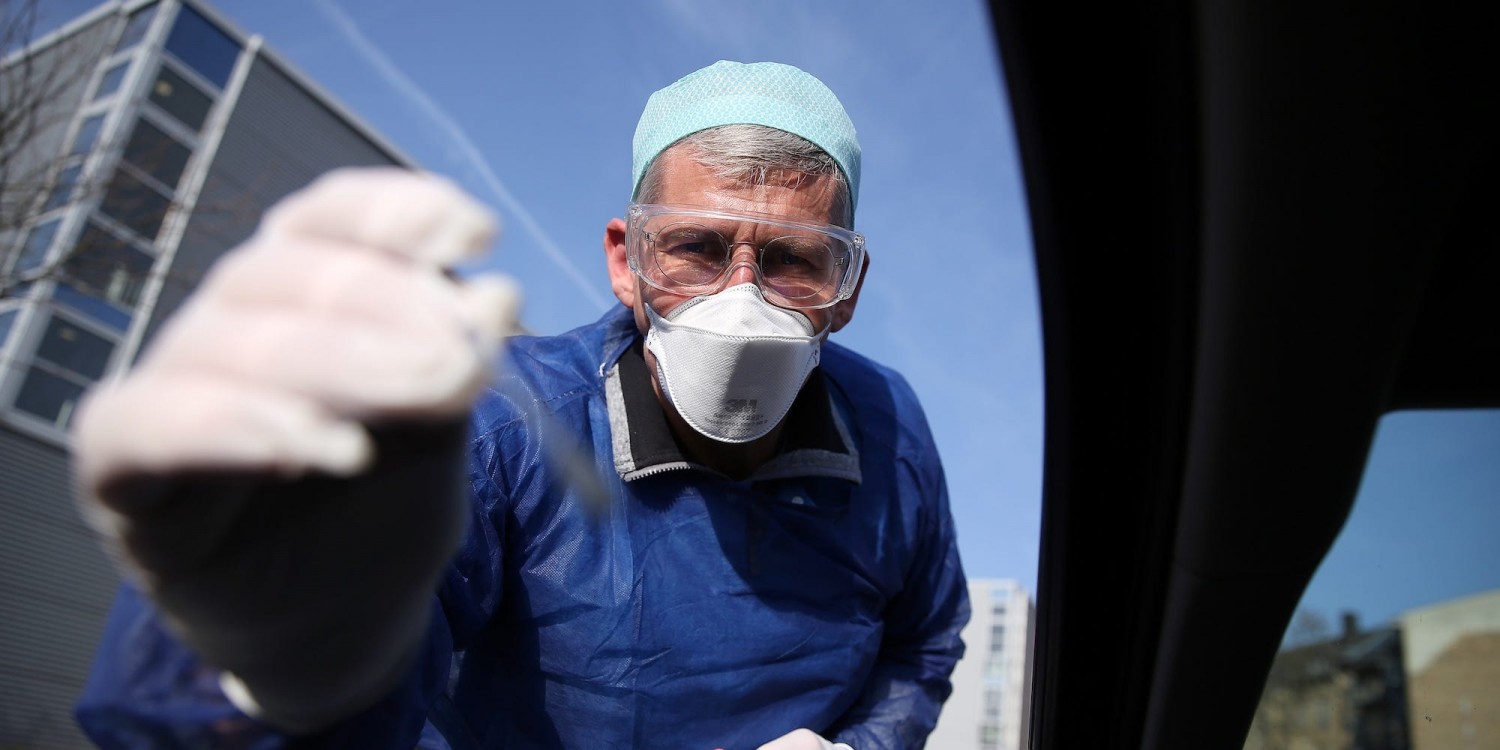
This article is more than
6 year old
The coronavirus is ravaging large parts of Europe, with Italy and Spain now the worst-hit countries in the world.
But to the north, Germany appears to be bucking the trend.
53,340 Germans had tested positive for the coronavirus as of midday Berlin time on March 28, with 397 deaths, according to the German newspaper Die Zeit. That means Germany has a death rate of 0.74%.
(Die Zeit's count pulls local data faster than the German central government, and is seen as a more accurate picture).
That rate is far below that of Spain, which at 7.82%, China at 4.02%, and Italy, which is at 10.56%.
It suggests that Germany is doing something right that the others aren't.
Here's why Germany seems to be on top of its coronavirus outbreak, and why its able to do things like take in coronavirus patients from its struggling neighbors.
The most important factor contributing to the low death rate is that Germany appears to be that it is testing far more people than any other European country.
Scientists agree that a large number — probably a big majority — of all coronavirus cases never make it into the official figures because they are not severe enough for hospital treatment.
The more widely a country tests, the more of these milder cases it will find.
Since the most severe cases are almost always tested, the number of coronavirus deaths will likely stay the same.
The net effect is that more testing leads to a lower-looking death rate.
Christian Drosten, director of the institute of virology at Berlin's Charité hospital estimates that Germany is testing 120,000 people a week. The German doctors' association says at least 200,000 coronavirus tests were carried out in recent weeks, The Independent reported.
"I believe that we are just testing much more than in other countries, and we are detecting our outbreak early," Drosten told NPR.
"We have a culture here in Germany that is actually not supporting a centralized diagnostic system," Drosten said. "So Germany does not have a public health laboratory that would restrict other labs from doing the tests. So we had an open market from the beginning."
As of March 28, the UK had tested 113,777 people. Spain and Italy are also not testing anywhere near as much.
The US had tested 626,667 people by March 28, according to the COVID Tracking Project. The figure has ramped up significantly in recent days, but still lags Germany's rate given that the US outbreak is now the biggest in the world.
Spain distributed 650,000 testing kits, but sent back a batch bought from China on Thursday after they discovered they were only identifying 30% of positive cases. It is not yet known how many tests have been carried out there overall.
The town of Vó in northern Italy quashed an outbreak after relentless testing, but the country as a whole has not been able to replicate the phenomenon.
On Friday, the Süeddeutsche Zeitung newspaper reported that Germany's Interior Ministry wanted to increase the number of daily tests to 200,000.
Germany is in good shape to fight its outbreak because it has a well-developed and comprehensive healthcare system, with both public and private options.
Germany spends $4,714.26 per person each year on healthcare, according to World Bank data from 2016. The figure is higher than most other nations.
Germany has the second-most critical care beds per capita in Europe, according to data from European Health for All. The beds are essential when trying to battle severe cases of the coronavirus.
Germany has 621 beds per 100,000 people. Italy has 275, and Spain 293.
"In general, we have a rather good intensive care situation in Germany," German virologist Martin Stürmer told Vox.
"We have highly specialized doctors and facilities, and maybe that's part of the reason why our severely ill patients survive compared to those in other countries."
The average age of a German infected with coronavirus is 46, whereas in Italy it is 63, according to Wired.
Older people are far more likely to die from the coronavirus, and most deaths occur in those with preexisting health conditions, which are more common in older people.
80% of all people infected in Germany are younger than 60, the Robert Koch Institute said on Monday, indicating that the outbreak hasn't yet taken hold in older people, where the risk of death is much higher.
In Spain the number of affected over-60s is around 50%.
Compared to countries like Spain and Italy, Germany is at an earlier stage of the outbreak.
"Germany's also a little bit earlier on in the process than Italy," Martin Hibberd, professor of emerging infectious diseases at the London School of Hygiene and Tropical Medicine, told Wired. "It takes two or three weeks of intensive care before people often succumb to the disease."
March 26 was Germany's worst day so far with 6,615 new cases reported. It seems likely that the daily number of cases will continue to rise.
Angela Merkel said on Thursday that it was too early to ease a lockdown that was put in place on Tuesday, according to German broadcaster Deutsche Welle. The infection rate was still increasing, Merkel said, but was likely to subside in the first week of April.
"The death rate in Germany is likely to increase as more older people become infected", Keith Neal, emeritus professor of epidemiology of infectious diseases at the University of Nottingham, told Sky News.
"The true death rate is probably going to be in the order of 1%."
Germany, like many other countries, enforced severe lockdown regulations, which began on March 24.
Gatherings were limited to two people, unless they are all members of the same family isolating together.
The fine for breaking the rules can be as much as €25,000 ($26,909.)
On Friday, Germany's Interior Ministry floated the idea of tracking its citizens via their smartphones to see who came into contact with someone infected with the coronavirus, according to Reuters.
It's easy to speculate on Germany's success, but some scientists have said that, because the outbreak is unprecedented, the answer may not be clear for some time.
Even some experts in German are arguing for caution.
"We don't know the reason for the lower death rate," Marieke Degen, deputy spokeswoman of the Robert Koch Institute told Vox.